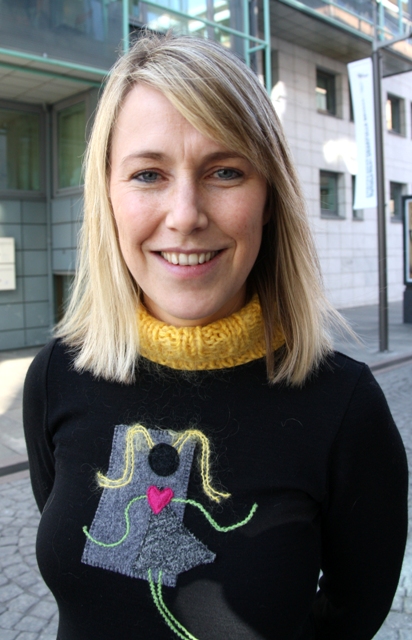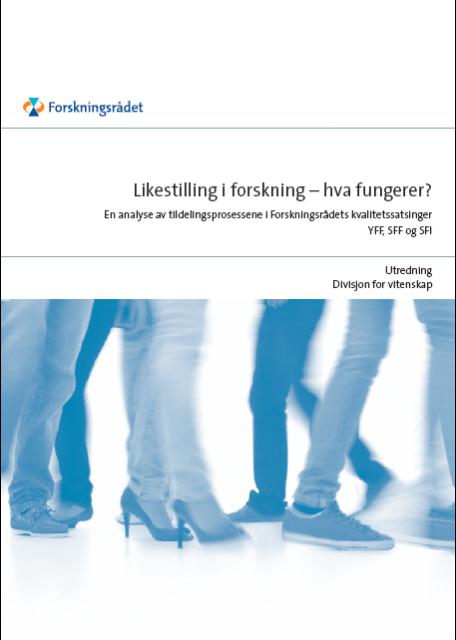Excellent – but not equal
More men than women receive funding when the Research Council of Norway grants money for outstanding research. Susanne Moen Stephansen has looked at how the attempts to bring more gender equality into these schemes have worked.
Separate money pools allocated for researchers and research communities that are considered to be “the very best” have become a common way to finance science. That these grants for a large part are awarded to men is also a well-known fact. Female scientists hold few of the leading academic positions and even fewer receive funding for their 'excellence'.

New report
According to a new report, Norway is no exception: When the Research Council of Norway in 2002 selected the first 13 centres of excellence none of them had women directors. The following year the Research Council granted funding for 26 outstanding young researchers; of these, only four were women. In 2005 the Research Council financed 14 centres of excellent innovation. Only one out of the 14 centres was headed by a woman.
These figures are revealed in the report Likestilling i forskning – hva fungerer? (Equality in science – what works?), which was presented at the Nordic conference (E)QUALITY 2009. The report is written by Susanne Moen Stephansen, who was commissioned by the Research Council to study the Norwegian schemes to support excellent research and how effective measures to improve gender balance in these schemes have been. Her report looks at how gender and gender equality have been taken into consideration in the process, and the effects of these considerations.
Young Investigators
The Research Council was met with criticism when they in 2003 announced that only four out of the 26 candidates who received funding from the Outstanding Young Investigators scheme (OYI) were women, and that most of the applicants who were accepted worked within the natural sciences and in the field of technology. The Research Council’s response was that the allocations reflected the applications they had received. The selection process was going to be a question of quality and quality alone. No other considerations were made.
But something happened before the second announcement in 2007. While women made up 15 percent of the recipients in 2003, they made up 40 percent at the time of the next OYI allotment.
"A number of changes were made between the first and second announcement. First and foremost, the application guidelines were altered. Women were encouraged to apply and the Research Council specifically stated that all fields of research were welcome," Moen Stephansen said at the conference.
In addition, the phrasing was made more inviting. For instance, the application form stressed that the applicants did not need to be top scientists yet, but that the OYI scheme could help them along the way. These changes may have contributed to increase the number of female applicants, says Moen Stephansen.
Changes in the assessment process
"Another development was that the applications in 2003 were treated the traditional way, in that each application was assessed by an individual referee. In 2007, however, three panels of international experts within different subject fields assessed the applications together."

The establishment of three panels, within the fields of biology, the humanities, and the natural sciences and technology, may have improved the chances for a broader range of applicants. This evened out the gap between the different fields of study, and this may again have led to a better gender balance, as the percentage of women is higher within the social sciences, medicine, biology and the humanities.
"In the last round moderate gender quotas were used. Where two applicants were equally qualified the female candidate was to be preferred. Three of the women who received funding were selected due to this measure," said Moen Stephansen, who believe that this was important to the final outcome.
Of the 36 applicants who were nominated by the expert panels, 31 percent were women. When three female applicants were prioritized in the final round the percentage of women was raised to 40 percent, she said.
Little debate
The increased female representation among outstanding young investigators is a story of success for the Research Council. The Centres of Excellence have less impressive results.
In 2001/2002 13 Centres of Excellence (CoE) were established in Norway. All the directors were men and so were the majority of the employees.
"In the initial announcement gender and gender equality was not an issue," says Moen Stephansen. Her report states that there was little debate surrounding the lack of gender balance, and the then chairman of the Division for Science, Knut Liestøl, describes this as a 'down period for gender equality work'.
However, changes occurred before the next round of announcements. The Research Council prepared the report Women in Science – from quotas to integration (Kvinner i forskning – fra kvotering til integrering), and the Committee for Mainstreaming – Women in Science was established.
"In the second announcement candidates were asked to incorporate a gender equality perspective in their application. It was also made clear that if two applicants had similar qualifications centres with female directors and centres with women in leading positions would be favoured."
Another measure was that the centres were asked to prepare action plans for gender equality with specific goals regarding female representation among researchers, PhD students and post docs. In addition, the Research Council earmarked money for gender equality measures.
Increased female representation
The result of this announcement was that one of the eight centres that were established had a woman director. This equals an increase in female representation of 12,5 percent.
"The Research Council is ambivalent as to whether the measure was effective at this level," says Moen Stephansen.

Her study shows that there has been a relatively modest increase in female representation among professors and researchers from the first to the second announcement. However, the number of women has gone up considerably among PhD students (from 35% to 53%) and post docs (27% to 44%).
"Female representation has increased between the two announcements. The question is if the increase has been so small that we can not be satisfied or if we should consider this a good start. One thing is clear; the figures have gone up the least in the area where we need it the most, in leading positions. These centres are now faced with the challenge of retaining their female PhD students and post docs," Moen Stephansen said.
She explained that in the end, no centres possessed similar qualities, so centres with female directors or a high female representation could not be preferred. Hence, moderate gender quotas were not used.
Falling behind
The last programme Moen Stephansen has looked at is the Centres for Research-driven Innovation (CRI). The objective is to promote business-oriented research by having top notch research groups collaborate with big research-intensive companies. A total of 14 centres for research-driven innovation were established in 2005. One of them had a woman director.
So far there has only been one announcement, but Moen Stephansen’s comparison of CRIs and CoEs shows that the CRIs are falling behind with regard to female representation on all levels.
"The reason may be that the Research Council had less focus on gender equality this time, but it may also be that this programme is more aimed at technological subjects," she said.
Translated by Vigdis Isachsen
Susanne Moen Stephansen has prepared the report Likestilling i forskning – hva fungerer: en analyse av tildelingsprosessene i Forskningsrådets kvalitetssatsinger YFF, SFF og SFI (Gender equality in science – what works: An analysis of the allocation processes for the Research Council’s programmes OYI, CoE and CRI) on behalf of the Research Council of Norway. The report is only published in Norwegian.
The report looks at gender and gender equality in the Research Council of Norway’s schemes to promote quality in Norwegian research; Outstanding Young Investigators (OYI), Centres of Excellence (CoE) and Centres for research-driven innovation (CRI). Two of these programmes, OYI and CoE, have had two rounds of announcements and allocations, while CRI so far has had only one announcement, in 2005.
